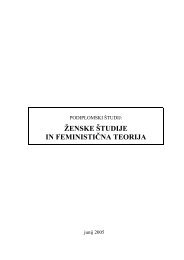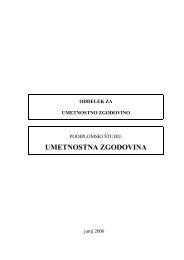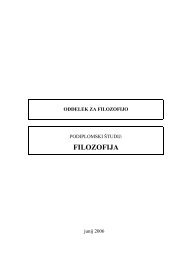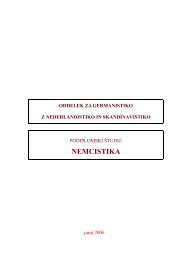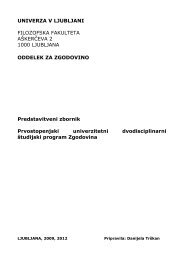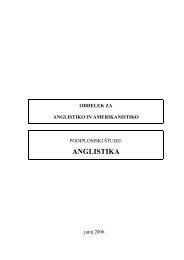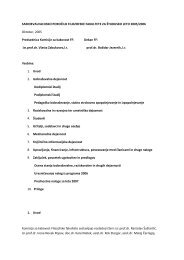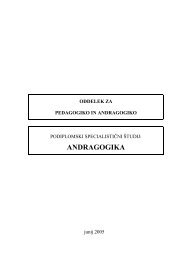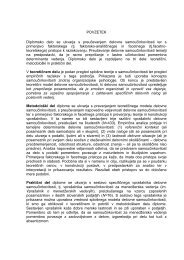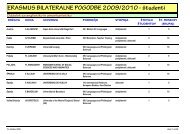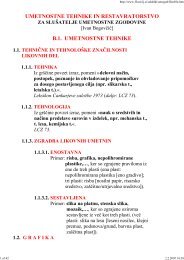LINGUISTICA XLIX - Filozofska fakulteta - Univerza v Ljubljani
LINGUISTICA XLIX - Filozofska fakulteta - Univerza v Ljubljani
LINGUISTICA XLIX - Filozofska fakulteta - Univerza v Ljubljani
Create successful ePaper yourself
Turn your PDF publications into a flip-book with our unique Google optimized e-Paper software.
4.1. Value A of scale 1.1 (= the type once) tends to combine with value C of scale<br />
1.2 (= low number). Value B of scale 1.1 (= the type four times) tends to combine<br />
with value D of scale 1.2 (= non-low number). Similarly in the remaining deductions,<br />
with the proviso that the alignment (unlike here) is chiastic in most cases.<br />
Chiastic alignment is explained below.<br />
4.2. Natural Syntax cannot predict the cut-off point between low and non-low numerals.<br />
4.3. The consequences (item 3 of any deduction) are meant to be universal statements.<br />
In some cases I could not avoid mentioning language-particular data.<br />
This deduction maintains that the state of affairs cannot be the reverse; i.e., that<br />
numerals above two (or three) would be one-word formations and that numerals under<br />
three (or four) would be two-word formations. All predictions of Natural Syntax are<br />
restricted to such modest claims about the unlikelihood of the reverse situation.<br />
In every deduction, the rules of alignment play a prominent role; compare item<br />
2 in the above deduction. The alignment rules regulate the combinations of corresponding<br />
values of the two naturalness scales mentioned in the deduction.<br />
The alignment can be parallel or chiastic. Suppose that the two scales are >nat<br />
(A, B) and >nat (C, D). Parallel alignment pairs value A with value C, and value B<br />
with value D. Chiastic alignment pairs A with D, and B with C.<br />
A paramount question is when the alignment is parallel and when chiastic.<br />
Parallel alignment is the default case. Chiastic alignment is necessary whenever a<br />
given deduction is limited to the language data obtaining within an “unnatural environment”.<br />
This is defined as value B of the scale >nat (A, B).<br />
An example. In the scale >nat (main, dependent) / clause, the value “dependent<br />
clause” is an unnatural environment. This means: all deductions whose language<br />
data lie within the environment “dependent clause” require the implementation of<br />
chiastic alignment.<br />
Chiastic alignment is prohibited when a naturalness scale is substantiated with<br />
an axiom. If, however, an axiom is engaged as one of the scales in a deduction, it<br />
obeys the usual distribution of the alignment rules.<br />
The insistence of Natural Syntax on the distinction between parallel and chiastic<br />
alignments stems indirectly from the work of henning Andersen within markedness<br />
theory. Andersen observes situations such as the following in all human semiotic systems:<br />
on an everyday occasion casual wear is unmarked and formal wear marked; on<br />
a festive occasion it is the formal wear that is unmarked, whereas casual wear is<br />
marked. See Andersen 1972: 45, especially fn. 23. This example expressed with our<br />
scales: (i) >nat (casual, formal) / wear, (ii) >nat (−, +) / marked. A third scale as the<br />
source of the environment of the deduction: >nat (everyday, festive) / occasion. If the<br />
environment is “everyday occasion”, the alignment within (i–ii) is parallel; if the<br />
environment is “festive occasion”, the alignment within (i–ii) is chiastic.<br />
Natural Syntax is a deductive theory and therefore my obvious chief aim is to disprove<br />
the theory. The (likewise obvious) strategy used is twofold: (1) the formal apparatus<br />
of the theory is gradually more and more constrained, and (2) I search for<br />
67



